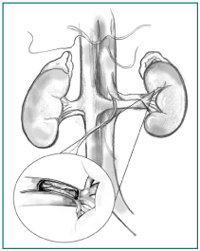Renal artery stenosis pathophysiology
|
Renal artery stenosis Microchapters |
|
Diagnosis |
|---|
|
Treatment |
|
Case Studies |
|
Renal artery stenosis pathophysiology On the Web |
|
American Roentgen Ray Society Images of Renal artery stenosis pathophysiology |
|
Risk calculators and risk factors for Renal artery stenosis pathophysiology |
Editor-In-Chief: C. Michael Gibson, M.S., M.D. [1] Associate Editor(s)-in-Chief: Shivam Singla, M.D.[2]
Overview
The reduction in renal blood flow secondary to renal artery stenosis stimulates renin release from the juxtaglomerular apparatus through activation of the tubuloglomerular feedback, baroreceptor reflex, and the sympathetic nervous system. Elevated angiotensin II activities in turn cause elevation of the arterial pressure and other effects including aldosterone secretion, sodium retention, and left ventricular hypertrophy and remodeling.[1]
Pathophysiology
Renal artery stenosis means the narrowing of both renal arteries leading to the on=bstruction of blood flow and resulting in the release of renin and activation of the renin-angiotensin-aldosterone system. This leads to the increase in production of aldosterone promoting increased retention of sodium and an increase in peripheral vascular resistance leading to increase renovascular hypertension that is also called secondary hypertension. Prolonged hypoperfusion to the kidneys resulting in chronic stimulation and hyperplasia of the juxtaglomerular apparatus. This prolonged ischemia further leads to renal insufficiency and inturn progressive renal atrophy.
